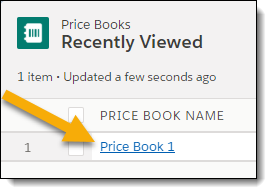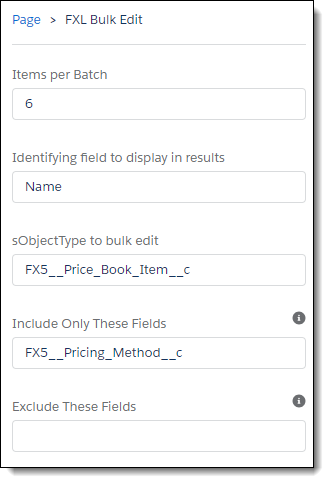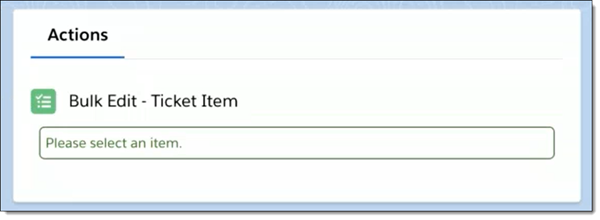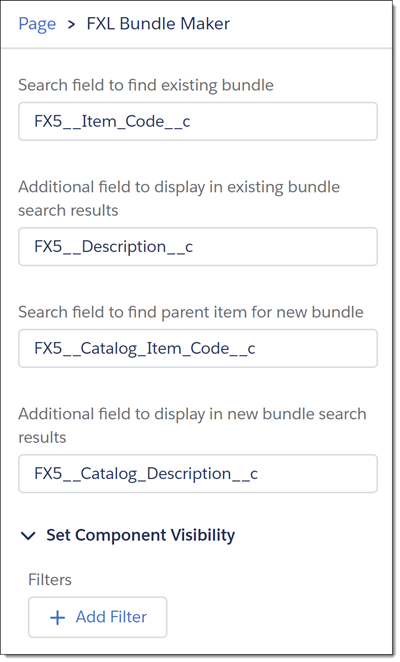FXL Data Grid Setup
Introduction
| For clarity and simplicity, the FXL Data Grid v2 will simply be referred to as the FXL Data Grid. |
When selecting the Lightning component, select the grid with "v2" appended to the name.
The FXL Data Grid is a versatile record management tool in FieldFX Back Office when using Lightning Experience. You can set up an FXL Data Grid for use with any record type in FieldFX. You can also set up FXL Bulk Editing, FXL Stage Pricing, and the FXL Bundle Maker for use with an FXL Data Grid after you have already added and configured it.
|
To use the FieldFX Lightning package starting with version 1.288, you must use the FieldFX Managed Package version 1.642 or higher. To find the version numbers you have installed, see Check Version Number for FieldFX Managed Package and FieldFX Lightning Managed Package. |
Prerequisites
To set up the FXL Data Grid, you need to:
| Have these user licenses | Have these permissions | Complete these tasks, some if using for the first time, and review these topics before continuing |
|---|---|---|
|
|
| Without permission to this Visualforce page, users will not be able to view the FXL Data Grid v2. |
Set Up FXL Data Grid
|
This grid only applies to Back Office and does not change what displays in Field FX Mobile. To see what determines what a user sees in the mobile app, see Configuring FieldFX Mobile Screens. |
-
Switch to the Lightning Experience.
-
Access the applicable record page.
Example 1. Use the FXL Data Grid to manage Price Book Item recordsScenario
You want to use the FXL Data Grid to manage price book item records.
-
From your Home page, click Price Books.

-
Click the price book for which you want to use the FXL Data Grid to manage price book items.

-
-
Complete the following before moving to the next step:
-
Set up Bulk Editing to be used with the FXL Data Grid.
-
Set up Stage Pricing to be used with the FXL Data Grid.
Add the FXL File Viewer Lightning Component
You can add the FXL File Viewer Lightning Component to a Job or Ticket page.
-
In FieldFX Back Office, select either a ticket or a job.
The process for adding the FXL File Viewer is the same for both. -
Click
 and select Edit Page.
and select Edit Page.The Lightning App Builder opens up.
-
Under Components, use the Search field and search for
fxl_file_viewer. -
Drag the component to a section on the record page.
-
You can add one or more optional filters for this component to filter the files shown.
-
Click Save.
-
Click Activation...
The Activation: Ticket Record Page window appears. If you have added the component to the Job Record Page, the title of the window is Activation: Job Record Page.
-
Click Close.
-
Click the return arrow to exit the Lightning App Builder and return to the Record Page.
The FXL File Viewer appears on the Record Page.

Configure Grid Details
The API names of Salesforce objects and object fields are required to configure any of the FXL Data Grid fields. The most accurate way to enter the API names is to obtain them from the Object Manager or from workbench.
| When working with the grid layout for the Delivery and Return Tickets in the latest Rental package, the Print button can’t be changed when configuring the ticket grids. |
|
The FXL Data Grid supports the use of and displays image fields as read-only. |
The examples are from Tickets and Quotes because these objects are very commonly used with the Grid. However, the grid is not limited to these objects and can be used with any object.
Disable Options
You can use these four options in the FXL Data Grid in the Disabled Grid Feature field either by themselves or in a comma delimited list:
| Option | Description |
|---|---|
GRID VIEWS |
Removes the user’s ability to change the sort criteria and to create a custom view allowing them to remove the stage number column. Enter 'Grid View' in the Disabled Grid Feature field. To re-enable, remove |
ROW SELECTION |
Enter To re-enable, remove Row Selection and tab away from the field. 
The indicator for the number of rows that were selected is removed, there are no checkboxes for the rows, and Delete button is not shown. 
With Row Selection and select the Disable multi-select and use single select checkbox, No radio button is displayed. 
|
DELETING ITEMS |
Removes delete button Enter To re-enable, remove |
FILTERING ITEMS |
Removes filter button Enter To re-enable, remove |
SORTING ITEMS |
Removes the sorting information from the header row. The grid column sorting is disabled. Enter To re-enable, remove |
Choose Columns for User Custom Views
| You must be an organization admin to set the columns a user can see and use for a custom view. |
-
Switch to the Lightning Experience.
-
Access the applicable record page.
Design Time Attributes
Design Time Attributes are divided into these subcategories:
|
|
For more information on these categories, see Configurable Fields in the FXL Data Grid v2 Configurable Fields.
Customize the Grid Heading and Title
You can customize the Grid Heading and Grid Title fields for the FXL Data Grid v2 on any records page where it’s used. If you leave these fields blank,
-
The Grid Heading defaults to
FXL Data Grid -
The Grid Title defaults to the item’s object label.
These properties also support using an expression to define its custom label. The correct format is (!$Label.customLabelName).
Create Custom Filters
We added the ability to create custom filters for a grid’s lookup fields.
Custom filters override Salesforce filters for lookup fields.However, you cannot save values if you try, a validation error results.
|
Custom filters are not supported for bulk edit. When adding new columns to a new lookup view, add the same columns to the default grid view. The new columns appear at the end of columns. If the user doesn’t have a default grid view, the columns will appear in the order they were entered in the settings. |
-
Create a Static Resource file named
fx_GridV2_CustomSearch.js -
Copy the sample file contents and then customize it for your needs
fx_GridV2_CustomSearch.jswindow.fx_GridV2_CustomSearch = { uid: { // [Unique ID of the grid] Contact_StartS__c: { // [Field Api Name] FX5__Contact__c: { // [Field Api Name] QueryFilter: "(LastName=NULL OR LastName LIKE 'S%')", // [Filter] QueryFields: "Name,LastName,FirstName", // [Display fields on lookup object] KeywordSearchFields: "LastName", // [Search fields on lookup object] OrderBy: "LastName" // [Sort field on lookup object] } }, // Multiple fields can be specified }, // Multiple grids can be specified };
| Custom filters allow for advanced queries.These queries can provide finely tuned results that are not possible apart from these programmatic custom filters. |
Advanced Custom Filter Scenario
|
The example scenario utilizes several additional fields and objects beyond standard FieldFX installations. Service Locations are not a standard feature of FieldFX. This example shows the power of custom filters beyond standard Salesforce capabilities. |
Scenario
When working with a Ticket, a field worker must select the service location where the work is performed, but should only see a list of service locations that are valid for the matching quote. Service Location appears on multiple grids on the Ticket object’s page layout.
window.fx_GridV2_CustomSearch = {
qiball: { // [Unique ID of the grid]
Service_Location__c: { // [Field Api Name]
Service_Location__c: { // [Field Api Name]
QueryFilter: "Service_Location__c=true AND Status__c!='Inactive' AND (Id IN (Select Service_Location__c from BTSL__c where Bill_To__c = '@@FX5__Quote_Item__c.FX5__Quote__c.FX5__CustomerAccount__c@@' AND Is_Active__c=true))", // [Filter]
QueryFields: "Name,AMS_ID__c,BillingCity,BillingState", // [Display fields on lookup object]
KeywordSearchFields: "Name,AMS_ID__c", // [Search fields on lookup object]
OrderBy: "Name" // [Sort field on lookup object]
}
},
// multiple fields can be specified
},
tiball: { // [Unique ID of the grid]
Service_Location2__c: { // [Field Api Name]
Service_Location2__c: { // [Field Api Name]
QueryFilter: "Service_Location__c=true AND Status__c!='Inactive' AND (Id IN (Select Service_Location__c from BTSL__c where Bill_To__c = '@@FX5__Ticket_Item__c.FX5__Ticket__c.FX5__Job__c.FX5__CustomerAccount__c@@' AND Is_Active__c=true)) AND (Id in (Select Account__c from Territory_Assignment__c where Territory__c = '@@FX5__Ticket_Item__c.FX5__Ticket__c.Territory__c@@' and Status__c='A'))", // [Filter]
QueryFields: "Name,AMS_ID__c,BillingCity,BillingState", // [Display fields on lookup object]
KeywordSearchFields: "Name,AMS_ID__c", // [Search fields on lookup object]
OrderBy: "Name" // [Sort field on lookup object]
}
},
// multiple fields can be specified
},
// multiple grids can be specified
};Create a Filter for Child Items
You can create a filter to:
-
To only see the Child Items that applies to child items only. Show only Child Items where Returned = true.
-
Combines parent and child item criteria. (For example, I want to see parent items with record type equipment and child items that have not been returned).
|
A child item filter can only be created if the API Name of the Parent Column is filled out. An error message appears when saving is ok. If the filter criteria filters out the parent item, any of the parent’s child items won’t show. |
-
In the Data Grid, open a Ticket that has parent and child items.
-
In the
Step-by-Step Guides
You can set up:
Add an Action Button
You can add an action button to the FXL Data Grid in FieldFX Back Office for tickets, quotes, and jobs.
Complete these steps in order to create the action button:
-
The AppSettings will differ depending on the button’s purpose.
Create in Back Office
-
Log into FieldFX Back Office.
-
From Setup, enter
objectin the Quick Find. -
Select Object Manager and then:
For a Job: For a Quote: For a Ticket: Select the Job object.
Select the Quote object.
Select the Ticket object.
-
Select Buttons, Links, and Actions from the menu.
-
Click New Action.
This action must be added to the Job, Quote, and Ticket objects. -
At the New Action window, complete the following:
Field Action Action Type
Select Lightning Web Components.
Lightning Web Component
Select
FX5:<name>.The
<name>is the name of the Lightning Component.Standard Label Type
Leave at
--None--.Label
Enter the text you want to use for this button.
Name
When you click on this field, it’s automatically populated by what you entered in the Label field. The spaces are replaced with underscores.
Description
(Optional)You can enter a short description of the button’s description.
-
Click Save.
-
Continue with Add to Page Layout.
Add to Page Layouts
-
While still in the Job, Quote, or Ticket object, select Page Layouts.
-
Select the object:
For a Job: For a Quote: For a Ticket: Job layout
Quote layout
Ticket layout
-
Click Mobile & Lightning Actions.
-
Find the new action that you created.
-
Drag the new action and drop it into the Salesforce Mobile and Lightning Experience Actions block under Job Detail.
If you don’t see the list of actions but see this message, this section is predefined by Salesforce.

Click the …override the predefined actions… link to expose those actions and add the custom action.
-
Only three buttons appear on the Job record. You can access the new button by selecting the down arrow and scrolling down the menu to the new button
-
If you want the new button to appear on the Job Record, drag the button to the first position in the Salesforce Mobile and Lightning Experience Actions block on the Job page layout
-
-
To save the changes, click Save.
The layout is saved and the list of page layouts reappears. -
Continue with Add the URL to Remote Settings.
Add the URL to Remote Settings
For more information, see Add Remote Site Settings for Lightning Components.
| If you have already added the Remote Site URL for another object, you won’t have to add it again. It already exists in your org. |
-
While still in Setup, use the Quick Find box and type
remote. -
Select Remote Site Settings.
-
Click New Remote Site.
-
At the Remote Site Edit, complete the following:
Field Action Remote Site Name
Enter the name for the site, such as the name for your new button.
The Remote Site Setting API Name can only contain underscores and alphanumeric characters. The name must:
-
Begin with a letter
-
Not include spaces
-
Not end with an underscore
-
Not contain 2 consecutive underscores
Remote Site URL
Enter the custom URL.
Disable Protocol
Security checkboxSelect this checkbox to allow s-controls to access this remote site regardless of HTTP or HTTPS session security. Only select this checkbox if you understand the security implications.
Description
(Optional)You can enter a brief description for the URL.
Active checkbox
Leave selected.
-
-
Click Save.
-
Continue with Add New AppSetting Fields.
Add New AppSetting Fields
With the button defined and on the page layout, you need to set up these AppSettings:
-
From Setup, enter
Custom Metadatain the Quick Find box. -
Select Custom Metadata Types.
-
In the AppSetting row, click Manage Records.
-
In the AppSettings window, click New.
-
Specify the AppSettings specific to the button you’ve added.
-
Click Save & New.
Set Up FXL Bulk Edit
The API names of Salesforce objects and object fields are required to configure the FXL Bulk Edit fields for the FXL Data Grid. The most accurate way to enter the API names is to obtain them from the Object Manager.
The object for FXL Bulk Edit must match the object for the FXL Data Grid you have already added and configured. You could also configure custom labels for the FXL Bulk Edit Lightning Component.
-
Drop FXL Bulk Edit to the record page with the FXL Data Grid already added and configured.
-
Select FXL Bulk Edit where it is placed on the page to display the configurable fields to the right.
-
Obtain the API name of the records' object and enter it in sObjectType to bulk edit.
-
Obtain the API names of any additional objects you want to display in FXL Bulk Edit and enter them separated by commas in Identifying fields to display in results.
-
You can also do one of the following:
-
Obtain the API names of the specific fields you want to limit bulk editing to and enter them separated by commas in Include Only These Fields.
-
Obtain the API names of the specific fields you want to exclude from bulk editing and enter them separated by commas in Exclude These Fields.

-
-
Click Save.
-
If this is the first time FXL Bulk Edit has been set up on the page, activate the configuration of the page as the Org default
-
Click Back.

-
Verify FXL Bulk Edit is displaying the object you selected.

Set Up Dependent Lookup Fields Bulk Edit
For most fields in FXL Data Grid, the default Salesforce Lookup Control functions as expected. The default lookup control does not work for dependent fields. You can use a custom search popup to get a filtered lookup for dependent fields.
-
Obtain the API names of objects for the dependent fields.
-
Obtain the API names of the dependent fields you want to filter for bulk editing.
-
Create or modify an fxl_searchSettings.js Static Resource file to include a
bulkEditfunction for the desired dependent field filtered lookup. -
Verify the Bulk Edit Control is added to the object’s lightning page.
-
Verify the fields have been added to the grid columns on the lightning page.
Example 1 - Bulk Edit Contacts Should Match the 'First Letter of Contact' Field
Scenario
On Quote Items, we have a verification that the entry in Contact field starts with the character entered in a first_letter_of_contact field.
When doing a bulk edit on the Contact field, only valid entries that match the entry in first_letter_of_contact for the controlling record should display.
| For this example, we assume the objects, fields, and verification rule already exist. |
To accomplish this lookup with verification for a bulk edit, the following code is added to the fxl_searchSettings.js Static Resource file.
bulkEdit: {
"FX5__Quote_Item__c": {
"Contact__c": {
"QueryFilter": "(LastName=NULL OR LastName LIKE '@@first_letter_of_contact__c@@%')",
"QueryFields": "Name,LastName,FirstName",
"KeywordSearchFields": "LastName",
"OrderBy": "LastName"
}
}
}Example 2 - Bulk Edit Wells for Selected Quote
Scenario
We have an object that tracks well sections.
The Quotes object has a reference field to the well sections object.
We also have a lookup from the Quote Items to the well section object.
When we are looking at Quote Items, we want to be able to bulk edit the well section, but the bulk edit should only allow well sections for the displayed quote.
| For this example, we assume that the objects and fields already exist. |
To accomplish this, we add the following code to the fxl_searchSettings.js Static Resource file.
bulkEdit: {
"FX5__Quote_Item__c": {
"well_section__c": {
"QueryFilter": "(Quote__c='@@FX5__Quote__c@@')",
"QueryFields": "Name",
"KeywordSearchFields": "Name",
"OrderBy": "Name"
}
}
}Set Up FXL Stage Pricing
You can stage pricing can be set up on Tickets and Quotes. The object for FXL Stage Pricing must match the object for the FXL Data Grid you have already added and configured.
Optionally, configure custom labels for the FXL Stage Pricing Lightning Component.
-
Drop FXL Stage Pricing to the record page with the FXL Data Grid already added and configured.
-
Click Save.
-
If this is the first time FXL Stage Pricing has been set up on the page, activate the configuration of the page as the Org default.
-
Click Back.

-
Verify FXL Stage Pricing is displaying where you expected.
Set Up FXL Bundle Maker
The FXL Bundle Maker enables dynamic parenting within the FXL Data Grid.
This component works on the following objects:
-
FX5__Ticket__cThe component defaults are configured for the Ticket object.
-
FX5__Quote__c -
FX5__Invoice__c -
FX5__Price_Book__c
The Bundle Maker works by searching for a parent item from items already on the grid (existing items) or adding a new item from the catalog.
| Parent items must be Price Book Items with Dynamic Parenting enabled. |
Optionally, configure custom labels for the FXL Bundle Maker Lightning Component. This allows for custom labels or internationalization (i18n) and translation.

-
Drop FXL Bundle Maker to the record page with the FXL Data Grid already added and configured
-
For Ticket record pages, the component is preconfigured.
For other objects, make the following entries:
Entry Description Recommended Entry Recommended Option Search field to find existing bundle
Field to search in the grid for the existing item to use as the parent.
Price Book
FX5__Catalog_Item_Code__cQuote
FX5__Catalog_Item__cInvoice
FX5__Catalog_Item__cAdditional field to display in existing bundle search results
Additional field to display for search results when searching the grid for an existing item to use as the bundle’s parent. A second line is added to the search results.
You should use a description field.
Price Book
FX5__Catalog_Description__cQuote
FX5__Description__cInvoice
FX5__Description__cSearch field to find parent item for new bundle
Field to search in Catalog items for a new item to use as the parent.
Price Book
NameQuote
FX5__Catalog_Item_Code__cInvoice
FX5__Catalog_Item_Code__cAdditional field to display in new bundle search results
Additional field to display for search results when searching Catalog Items for a new item to add to the grid to be the bundle’s parent. A second line is added to the search results.
You should use a description field.
Price Book
FX5__Catalog_Description__cQuote
FX5__Description__cInvoice
FX5__Description__c -
Click Save.
-
If this is the first time the FXL Bundle Maker has been set up on the page, activate the configuration of the page as the Org default.
-
Click Back.

-
Verify FXL Bundle Maker is displaying where you expected.
Recommended Reading
-
FXL Data Grid - Learn how use the FXL Data Grid.
-
FXL Bulk Edit - Learn how to use FXL Bulk Edit.
-
FXL Stage Pricing - Learn how to use FXL Stage Pricing.
-
FXL Bundle Maker - Learn how to use FXL Bundle Maker.
-
FXL Components Overview - Learn how to use the components that are available in FieldFX Lightning